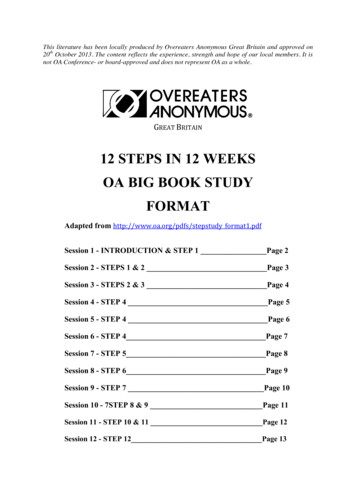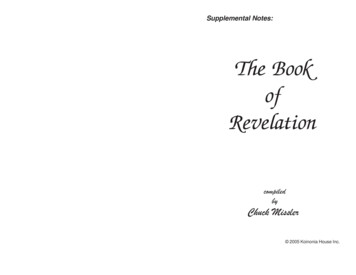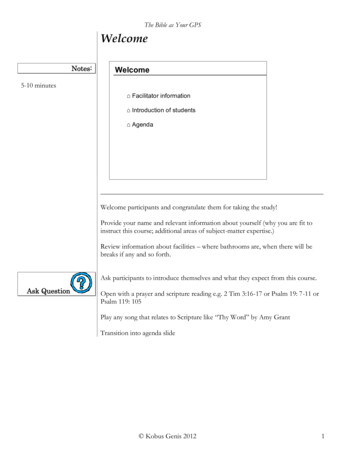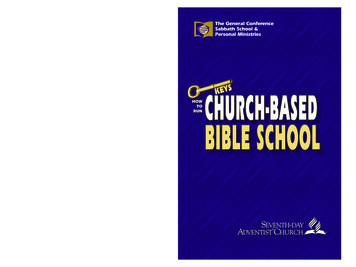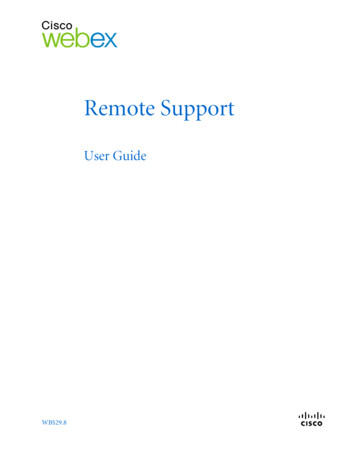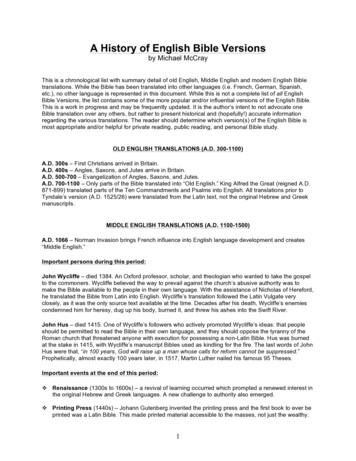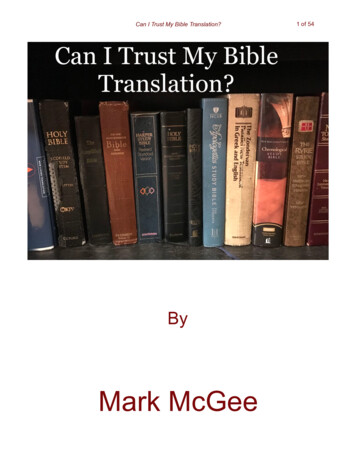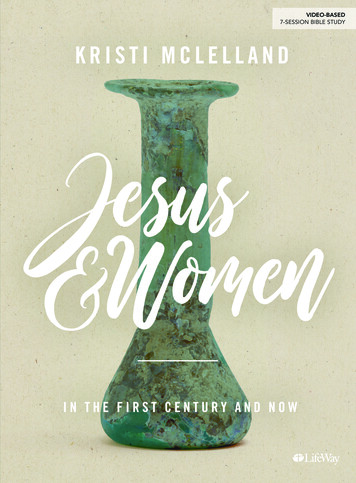
Transcription
VIDEO-BASED7-SESSION BIBLE STUDY
LifeWay Press Nashville, Tennessee
Published by LifeWay Press 2019 Kristi McLellandAll rights reserved. No part of this work may be reproduced or transmitted in any form or by any means, electronic ormechanical, including photocopying and recording, or by any information storage or retrieval system, except as maybe expressly permitted in writing by the publisher. Requests for permission should be addressed in writing to LifeWayPress ; One LifeWay Plaza; Nashville, TN 37234.ISBN: 978-1-5359-9203-9Item: 005821584Dewey decimal classification: 248.843Subject heading: JESUS CHRIST / WOMEN / MIDDLE EAST / BIBLE—SOCIAL LIFE AND CUSTOMSUnless otherwise noted all Scripture quotations are from the THE HOLYBIBLE, NEW INTERNATIONAL VERSION , NIV Copyright 1973, 1978, 1984, 2011 by Biblica, Inc. Used by permission. Allrights reserved worldwide. Scripture quotations marked CSB are takenfrom The Christian Standard Bible. Copyright 2017 by Holman BiblePublishers. Used by permission. Christian Standard Bible , and CSB are federally registered trademarks of Holman Bible Publishers, all rightsreserved. Scripture quotations marked KJV are from the Holy Bible,King James Version. Scriptures marked NRSV are from the New RevisedStandard Version Bible, copyright 1989 the Division of ChristianEducation of the National Council of the Churches of Christ in the UnitedEDITORIAL TEAMADULT MINISTRYPUBLISHINGBecky LoydDirector, Adult MinistryMichelle HicksManager, Adult MinistryShort Term Bible StudiesSarah DossContent EditorStates of America. Used by permission. All rights reserved.Erin FranklinProduction EditorTo order additional copies of this resource, write LifeWay ChurchLauren ErvinGraphic DesignerResources Customer Service; One LifeWay Plaza; Nashville, TN 37234;Fax order to 615.251.5933; call toll-free 800.458.2772; emailorderentry@lifeway.com; or order online at www.lifeway.com.Printed in the United States of America.Adult Ministry PublishingLifeWay Church ResourcesOne LifeWay PlazaNashville, TN 37234Micah Kandros DesignCover Designer
TABLE OF CONTENTS4ABOUT THE AUTHOR5INTRODUCTION8HOW TO USE THIS STUDY10SESSION ONE: MEETING THE MIDDLE EASTERN JESUS28SESSION TWO: JESUS AND WOMAN IN THE FIRST-CENTURY WORLD46SESSION THREE: JESUS AND THE WOMAN AT THE WELL64SESSION FOUR: JESUS AND THE WOMAN AGAINST A WALL82SESSION FIVE: JESUS AND THE WOMAN WITH CHUTZPAH100SESSION SIX: JESUS AND THE WOMAN ON THE SOUTHERN STEPS118SESSION SEVEN: JESUS AND THE TALE OF TWO MARYS134WRAP-UP: CELEBRATION138LEADER GUIDE144GLOSSARY154ENDNOTES3
ABOUT THE AUTHORKristi McLelland is a speaker, teacher, and collegeprofessor. Since completing her Masters of Arts inChristian Education at Dallas Theological Seminary,she has dedicated her life to discipleship, to teachingpeople how to study the Bible for themselves, and towriting about how God is better than we ever knew byexplaining the Bible through a Middle Eastern lens.Her great desire for people to truly experience the loveof God birthed a ministry in which she leads biblicalstudy trips to Israel, Turkey, Greece, and Italy.For more information about Kristi and what she’s up to,visit: NewLensBiblicalStudies.com.4JESUS AND WOMEN
INTRODUCTION“A BIBLE WITH ITS JEWISHNESS WRUNG OUT OF IT ISNO BIBLE. A CHRIST WITH HIS JEWISHNESS OBSCUREDIS NO CHRIST AT ALL.” 1—DR. RUSSELL MOOREEvery adventure begins in a moment, and the best ones come to us. In 2007 anadventure found me. The Lord opened the door for me to go study the Bible inEgypt and Israel.At the time, I was teaching Bible in the Biblical Studies department at WilliamsonCollege. I went to the Middle East in a spirit of professional development, just tolearn, but God had other plans—much better plans.In Israel I was amazed to see how different the Middle Eastern culture was and isfrom our Western culture. I started noticing how I was approaching the Bible as aWesterner, seeing it with Western eyes and asking Western questions of the biblicaltext. In Israel I learned the Bible through a cultural lens, the Middle Eastern lens.In these early days of my Middle Eastern study, God totally and thoroughlywrecked me in the best of ways. He completely transformed me.Learning the Bible in its original historical, cultural, linguistic, and geographiccontext allowed me to get to know Jesus in His Jewish world. I didn’t just fly overto Israel; it felt almost as if I went back in time to learn about the first-centuryworld of the Bible, the world Jesus lived in two thousand years ago.“WE HAVE FORGOTTEN THAT WE READ THE BIBLE ASFOREIGNERS, AS VISITORS WHO HAVE TRAVELED NOTONLY TO A NEW GEOGRAPHY BUT A NEW CENTURY. WEARE LITERARY TOURISTS WHO ARE DEEPLY IN NEED OFA GUIDE.” 2—GARY M. BURGE5
You may be wondering about the meaning behind the cover of our study. The vesselpictured there is a tear jar, an actual archaeological artifact dating back to the firstor second century AD. It was uncovered in Israel where one of my professors gaveit to me as a gift.This tear jar most likely belonged to a Jewish woman in antiquity, maybe even inthe lifetime of Jesus’ earthly ministry. In the ancient Near East, Jewish womencollected their tears in a tear jar and poured them out to God in worship asa sign of faith, embodying God’s message in Psalm 56:8 where He says He keepsour tears in a bottle. I look at the tear jar often and wonder what the originalowner’s story might have looked like—what she experienced, her highs and lows.I wonder where she kept her jar and how often she pulled it out to collect her tearsbefore the Lord.To me, the tear jar represents some of what the woman in Jesus’ first-century worldwould have experienced. She was not always valued by society; she was often marginalized in the culture of the day. And yet God saw her grief and her struggle. Heencouraged her to bring the pain to Him in worship and prayer. And, then, in Jesus,He worked to restore woman and show her His redemptive purposes in her life. Hevalued her; He lifted her up out of shame. He set her on the path to life. And Hedesires to do the same for you and for me, as followers of Christ.I went to Israel and learned that God is better than I ever knew.This understanding of who God is has changed me, and it’s changing me still.I believe it will do the same for you. My time in Israel marked my life and shiftedits direction entirely. I’ve been taking teams to Israel for biblical study trips eversince my first study trip in 2007. The gift given to me has become my gift to giveothers. My hope is for this study to be that gift to you.The Bible was primarily written by Middle Easterners in a Middle Eastern context.Deeper insight into the Middle Eastern culture and historical context of the timein which the Bible was written will greatly add to our understanding of what thebiblical authors meant by what they wrote and what the people described in theBible did.One of the major differences between Western and Eastern culture is how we teachand how we learn. We, in the West, are more of a Greco-Roman culture. We prize6JESUS AND WOMEN
literature. We read sitting at desks, study with books in our hands, take notes, fill inthe answers, and finish our workbooks.Teaching and learning are different in the Middle East—they’re different now,and they were different for Jesus in His time on earth. Middle Eastern teachingis visual; a rabbi teaches on the go. When Jesus taught, He could usually see theobject of His lessons, and His disciples could see it too. This teaching style was notphilosophical. It was right here. It was not “up there;” it was “down here.”Jesus’ style wasn’t to provide a syllabus or a workbook. He was more likely to walkthrough a field of mustard seed while sharing a parable about how the kingdom ofGod is like a mustard seed.In the Middle Eastern tradition of learning, the student wants to stay very closeto the rabbi so as not to lose any of his words. And the student never knows whenor where the rabbi will begin teaching! In the Middle Eastern way, students learnthrough discovery rather than the acquisition of knowledge. This is how a rabbiteaches—he guides you into discovery. And this is how I want to guide you throughour seven weeks together.We are going to strive to view the Bible with a Middle Eastern lens and, at thesame time, study a few Bible passages in a traditionally Jewish way, the way rabbisstill teach the children in Israel today. We will walk into discoveries together ratherthan simply being taught the content or lesson.This seven-week feast is my attempt to set a biblical table around which we cancome together and discover Jesus’ heart for women in His first-century world. Atthis table, we take off our Western lenses and put on our Middle Eastern lenses.I’ll continue to share bits and pieces along the way to guide you in shaping yourMiddle Eastern lens.I’m so honored and expectant to share in this seven-week biblical feast with you.In some ancient way, the Lord saw this for us before the foundations of the worldwere ever even laid. He’s drawing us to this table, and He will do the feeding.Posture yourself to receive.All the best,INTRODUCTION7
HOW TO USE THIS STUDYIn our time together, we’re going to study God’s Word in a way that might seem a bitdifferent from what you’ve experienced in the past. As I mentioned in the introduction,we are going to strive to view the Bible with a Middle Eastern lens and, at the same time,study a few Bible passages in a traditionally Jewish way, the way the rabbis would havetaught Jesus the Bible, the way some rabbis still teach the children in Israel today.With that in mind, let’s discuss a bit of the framework for our study:We approach the Scriptures as children expecting to be fed by our Father.It can be easy to sit down with our Bibles and think something like, OK, let me figure outsome application from the passage I’m reading today. I have good news for you—we are notspiritual orphans. We have a gracious heavenly Father who feeds us to the full with HisWord; He gives abundantly. As we read the Word, we do our part by being open to whatGod will teach us. We posture ourselves to obey and to be gratefully fed by the Living Godthrough His Word and by the power of His Spirit. But God is in charge of feeding us.We’re not looking for the “right” answer.Though it may sound strange to our Western ears, in Judaism, the student with goodquestions is better than the student with all of the right answers. We never just readthe Bible; we interact with it, asking questions of the text. We want to know what atext teaches us about God before we ask what it teaches us about ourselves. In our timetogether, we’re going to focus on interacting with the biblical text in community, andwe’re going to learn to be OK with questions that cannot be easily answered and evenquestions that may leave us scratching our heads with a bit of mystery.We want God’s Word to become a part of who we are.The Middle Eastern way of learning falls in line with more of an oral teaching tradition,less so the more formal learning style of our Western world. In our study together, wewant these concepts in God’s Word to get into our hearts and minds so much that theybecome a part of who we are, changing the way we see God and interact with the world.You’ll notice we will revisit some of the same concepts each week; the study is intentionally crafted in this way. By the end of our time together, I hope these biblical concepts areso clear and familiar they are almost like second nature to you.8JESUS AND WOMEN
Learning will be a community endeavor in our time together.In the Middle Eastern way, learning is very communal. Here’s what I mean: in a MiddleEastern context, it would be common to see rabbis teaching students as they walk down theroad. This teaching tradition places significant value on students discussing an issue with oneanother. Rabbis often instruct their students to “go first” and discuss what they believe abouta teaching before the teacher explains the concept to them. We’re going to adopt some ofthose ideas in our time together. In many cases, I’ll “go first” in our feast teaching times. Butyou’ll notice group discussion guides that I’ve crafted especially for you to use as you yeshiva,or discuss biblical texts together, after we begin unpacking them in our video teaching times.Each week, you’ll find the following sections:The Watch section includes summaries of our video teaching, to help you as you follow along.Feel free to add your own notes here as you watch.The Discuss section includes questions (based on the video teaching and the personal studyeach week) for your small group to explore together.In the Follow-up section, we’ll dive into further insight on a topic we discussed in our feastteaching times.In the Look section, we’ll highlight a Middle Eastern insight or cultural emphasis morein-depth to further your understanding of Jesus’ first-century world.In the Learn section, we’ll take a passage of Scripture and consider it in light ofa Middle Eastern lens.In the Live section, we’ll take some time to help you apply the concepts you’re learning toyour own life.The Watch and Discuss times are meant to be completed with your small group. But theFollow-up, Look, Learn, and Live sections are for your personal study time. Instead of labelingthem by days of study, we’ve labeled them by sections. Feel free to complete each between ourweekly group times as you see fit throughout the week. Please note, terms in the text markedwith this style are explained in further detail in the glossary on pages 144–153.Let’s get started.9
SESSI ON ONEMEETINGTHE MIDDLEEASTERNJESUS10
INTRODUCTIONAs we prepare to watch our first video teachingtogether, we are getting ready to pull up our chairsfor Session One of this biblical feast. I call our studytimes together feasts because we don’t so much readthe Word of God as eat it. We take it in—we let it doits work in us.For me, the best meal is one I do not have to cook, and that’s absolutely truewhen we come to the Word of God. God prepares this feast for us. We come tothis moment and to this table believing the Living God will feed us. We are notorphans, and we are not fatherless. We do not have to scrounge, strive, or strain tofeed ourselves the Word of God. We can simply, yet profoundly, posture ourselvesto receive the feast the Lord has prepared for us—for you.As we come to this biblical table, before you watch the video teaching, take a fewmoments to answer the following questions:Why did you say yes to this feast?What are you asking the Lord to do in your life through this seven-weekfeast?Finish this sentence:“I am here because my heart needs .”Sit back. Breathe deep. Enjoy the feast!12JESUS AND WOMEN
WAT C HTHE FEASTUse the following notes and space provided during our feast teachingtime. Feel free to add your own notes as you watch.We eat the Word of God. It is sweeter than honey (Ps. 19:10).We do not scrounge, strive, or strain to feed ourselves the Word of God. We postureourselves to receive from God (Ps. 81:10).We tend to stare at our lives and glance at God. We want to stare at God andglance at our lives.The right hand in the biblical world was the hand of favor, honor, blessing, andsonship (Ps. 110:1).We want to be a “right-hand people,” who bless and honor others.Western learning is different from Middle Eastern learning. Most of the Bible waswritten by Middle Easterners in a Middle Eastern context. In our time together, wewant to learn to read the Bible through a Middle Eastern lens.#JesusAndWomenStudyMEETING THE MIDDLE EASTERN JESUS13
WAT C HWESTERN LENSMIDDLE EASTERN LENSFormFunctionHow?How did it happen?Why?Why would God do that?Understand è BelieveBelieve è UnderstandLaw, Rule, PrincipleStory, NarrativeWhat does it teach me about me?What does it teach me about God ?Dig deep, get down in it (Analysis—pick it apart)Read through it (Synthesis—bring it together)Study to acquire knowledgePosture to be fedReading the Bible through a Middle Eastern lens adds to our understanding ofwhat the biblical authors and people featured in the Bible meant by what they saidand did.We want to live like rivers, not lakes. We want the Word to travel to us, through us,to others.We have truly learned a thing when we can give it away.14JESUS AND WOMENTeaching sessions available for purchaseor rent at LifeWay.com/JesusAndWomen
WAT C HMEETING THE MIDDLE EASTERN JESUS15
DISCUSSLET’S YESHIVA!As we discussed in our first “biblical feast” together, MiddleEasterners most often learn and cultivate spiritual growthwithin the context of community and group conversation.With this cultural difference in mind, each week we’regoing to practice yeshiva together—what we might call“workshopping” or “brainstorming” around a topic in ourWestern culture—dialoguing openly about a biblical conceptand walking together as a community with Jesus as our Rabbi.Discuss the following questions with your group.What did you just hear or see in our feast togetherthat you want to remember?What one thing that we learned in our feast would youwant to share with others this week?What would it look like for you to posture yourself toreceive when you read your Bible?How does the concept of eating the Word of Goddiffer from reading the Word of God?Which element on the Western versus Middle EasternLens Chart (p. 14) stuck out to you the most?What in your life right now makes you want to reachout and touch Jesus’ wing?What do you think people two thousand years agowould have noticed the most about Jesus?What do you think would have made Jesus seemdifferent or “other” to the people of His day?16JESUS AND WOMENYESHIVAToday, yeshiva is a formalterm referring to anestablished educationalsystem that focuses onstudying the Torah andthe Talmud. 1In the first century,however, the emphasislay in how a teacherinterpreted a specificpassage of Scripture ortheological concept andwhether that teachingwas valid. 2 How would acommunity determinethe validity of a biblicalteaching? Yeshiva.Stemming from theHebrew verb meaning“to dwell,” yeshivaoccurred when studentswould discuss or debatequestions or commentsfrom a teacher. 3
FOLLOW-UPLIVING LIKE A RIVER, NOT A LAKEI’ve been taking team members to the Jordan River for eleven years now. TheJordan River flows from the Sea of Galilee into the Dead Sea. The water moves,4flows—it’s living water, mayim chayim. I’ve also floated in the Dead Sea foreleven years now. The water in the Dead Sea is still, motionless—it’s dead water.As a college professor, I tell my students all the time, “You haven’t learned a thingwhen you’ve seen it. You haven’t learned a thing when you’ve heard it. You haven’tlearned a thing when you have seen and heard it. You’ve learned a thing when youcan give it away.” We want the Word of God to travel through us to others, movingfreely as a river would. We are not supposed to hold what God is teaching us toourselves, motionless like the Dead Sea.The things the Lord reveals to you—feeds you in this feast—are meant to travelthrough you to others. We want to live like rivers, not lakes.Consider the following questions and record your answers below:How can this feast travel through you this week?Who needs to hear the truths you’ve learned at this week’s feast?Who can you be a river for this week?MEETING THE MIDDLE EASTERN JESUS17
LOOKTALLITTORAHJust as Christians havesubdivided the Old Testamentinto categories (for example,Law, History, Poetry, MajorProphets, Minor Prophets),the Jews have divided theirsacred text. Torah is a section ofJewish Scripture that includesinstruction and the Law.For the Jews, nothing ismore important than Torah.It’s the first place they gowhen deriving authority fromScripture. The books of Torahinclude Genesis, Exodus,Leviticus, Numbers, andDeuteronomy—what scholarstoday call the Pentateuch(literally “five books”). Thoughtraditionally translatedas “law,” the word Torahimplies instruction more thanlaw. According to Torah, thecommandments offer freedommore than oppression. Theyserve as parameters that allowa person to function well in herfamily, tribe, and nation. 518JESUS AND WOMENThe tallit is a prayer shawl. It has been used and isstill used today in a variety of ways, depending on aperson’s tradition and orthodoxy. The tallit is oftenworn in prayer and worship. 6 In Numbers 15:37-40 andDeuteronomy 22:12, the Torah instructed the Israelites toput tassels (tzitzit) on the corners of their garments. 7The LORD said to Moses, “Speak to the Israelitesand say to them: ‘Throughout the generationsto come you are to make tassels on the cornersof your garments, with a blue cord on eachtassel. You will have these tassels to look at andso you will remember all the commands of theLORD, that you may obey them and not prostituteyourselves by chasing after the lusts of your ownhearts and eyes. Then you will remember toobey all my commands and will be consecratedto your God.’”NUMBERS 15:37-40Make tassels on the four corners of the cloak youwear.DEUTERONOMY 22:12
Each tzitzit (tassel) contains several little knots—fora combined total of 613 knots on a tallit, each representingone of the commandments in the Torah. 8 Every time theIsraelites saw the knots on the tassels, they were to rememberthe commandments. The Hebrew word used for the cornerof the tallit, kanafayim (corners), can also mean “wings.” 9Likely, the tassels were permanently fixed on the corners orwings of the outer hem of the garment.Each knot represents thecommandments—the instructionsto live in shalom—to keep the wayof life in front of God’s people.The Torah also instructed the Israelites to run a blue orviolet cord through the tassels on their tallits. Both rabbinicsources and archaeological data tell us the blue dye used tocolor these tassels was made from a gland of the Murex snail(located in the Mediterranean). Each snail produced a verysmall amount of dye, making it very expensive. 10Neighboring cultures used the colors blue and violet assymbols and signs for royalty. For the Israelites, this blueor violet cord may have been a sign or a symbol of the royalstatus of the entire community. The Israelite priests woreephods, sleeveless garments, made with blue, purple, andscarlet yarn (Ex. 28:6). The blue cord in every Israelite’s tasselsymbolized they were all to be a royal priesthood among thenations—each and every one of them.This idea of the royalty of the nation of Israel was tied toGod’s covenant relationship with them. The Israelites werenot royal because of any worldly qualifications, but they were aroyal community because they were God’s people (Deut. 7:6-7).God set them apart with His love, and His love lifted them up.GOD NOT ONLYFREED THEISRAELITES FROMSLAVERY, BUT HEIMMEDIATELYREMINDED THEMTHAT HE MADETHEM REGAL ANDROYAL.God’s choice to remind His people of their royal lineage inHim is especially impactful when you consider the fabric of Israelite culture and theirnational identity at the time God gave them this instruction. When God told themto run regal cords through their tassels, the people were still working to shed thenational identity they had borne for so many years in Egypt, an identity associatedwith the onus of slavery. And God not only freed them from that slavery, but Heimmediately reminded them that He had made them regal and royal. It was as if Godwas saying, “I know what Egypt said you were and how you were mistreated there.MEETING THE MIDDLE EASTERN JESUS19
But I say you are a royal priesthood, a holy nation set apart by My love. Live in theidentity I have given to you, forgetting any other label the world has tried to placeon you.”READ MATTHEW 9:20-22.In Matthew 9 we see a woman with an ongoing issue of blood that had lastedtwelve years. This condition would have rendered her unclean according to Jewishlaw. Being considered unclean according to Jewish law had some significant effectson her day-to-day life. She would not have been able to attend temple or synagogue; in this time and culture, that prohibition amounted to effectively being cutoff from the religious community and teaching. God’s people and God’s house,places where we often find refuge and solace today—especially in times of suffering—were not a refuge for her. In fact, the religious community had effectivelyturned its back on her and avoided association with her.She would have been considered on the “outside” of the social world— in otherwords, “socially dead.” These considerations are especially painful when youremember the communal nature of the Middle Eastern culture. This woman wouldhave been shunned from society to the point that even her family members wouldnot have been allowed to touch her or comfort her physically without becomingceremonially unclean and excluded from the community until they could be rituallycleansed. 11 It’s hard for us to fathom how alone she must have felt.Take a moment to imagine what this woman’s world and life must havebeen like. What do you think she would have most desired? What doyou think might have caused her the greatest pain?This woman, the one who had been dealing with yearsof pain—physical, emotional, and spiritual—reachedfor the “edge” of Jesus’ cloak (v. 20). The Greek wordfor “edge” used in this passage is kraspedon. 12 This sameword appears in the Septuagint, the Greek translation of the Old Testament, in reference to the tassels20JESUS AND WOMEN
that all Jews fixed on the “edges” or “corners/wings” of their outer garments. TheHebrew word for “edge” is kanafayim.The woman with the issue of blood reached for Jesus’ healing kanafayim/kraspedon—corner, edge, wing —of His tallit.READ MALACHI 4:2.Consider what it must have taken for this woman to reach out to Jesus—a womanwho had been isolated from the community of God’s people and access tospiritual teaching. I believe this woman acted out of significant faith. I think thatin reaching out to grab the wing of Jesus’ tallit, she was taking God at His Wordin Malachi 4:2 and was asserting her belief in Jesus as the Son of God. In spite ofall she had been through, in spite of the way the religious community had probablyshunned her, she exerted faith in Jesus. She placed her hope in God’s promises, inGod’s character.This scene in Matthew 9 seems to be a literal fulfillment of Malachi 4:2—“the sunof righteousness will rise with healing in its wings” (CSB).And don’t miss this. In this moment, Jesus rewarded her faith, healed her, andbrought her back to life within her Jewish community. He provided physical andspiritual healing. By reaching out to her, He helped usher her back into societyand stuck up for her in the eyes of the world. In her cultural context, the idea ofsomeone unclean touching a holy rabbi like Jesus would have been scandalous andrisky. According to the tradition of the day, Jesus would have had every right toreact harshly toward her and dismiss her, maybe even kill her. 13Pay close attention to Jesus’ reaction here. He didn’t condemn. He didn’t dismiss.Instead, the Bible says Jesus turned to her, He saw her, and He said, “Take heart,daughter your faith has healed you” (Matt. 9:22). What a gospel-gorgeous truth.Praise the Living God.In what area of your life do you need to hear God say, “Take heart,daughter”? Describe it below. Feel free to use a journal if you needmore room to write. How does this story from Matthew 9 encourageyou in that circumstance?MEETING THE MIDDLE EASTERN JESUS21
LEARNCARRYING THE WILDERNESS WITH YOUREAD EXODUS 3:1-10.Look at this Bible passage through the Western lens, asking thequestion, “How did it happen?” Write down what you notice inthis story.Look at this Bible passage through the Middle Eastern lens, asking thequestion, “Why would God do that?” Write down what you notice inthis story.This story happened in the desert, in the wilderness. Moses was tending his fatherin-law’s flock on “the far side of the wilderness” (v. 1). We often think of a desertor wilderness as something we want to get out of. But the Jewish people view thedesert as the place where the Lord often meets His people and speaks to them.The Lord met Moses in Exodus 3 in the desert and spoke to him. The Lord gaveHis Torah to His people at Mount Sinai in the desert (Ex. 20). He met Elijahin the desert and spoke to him in “a still small voice” (1 Kings 19:12, KJV ). TheSpirit led Jesus into the desert after His baptism. Angels attended to Him after Hisforty-day fast, His encounter with the devil, and His temptings (Matt. 4:1-11).In the desert—the wilderness—God meets you and teaches you unique lessons thatthese dry and barren places frame in a way no other place would. In the MiddleEastern culture, the wilderness is seen almost as a sacred place, a place of intimacy,where God speaks a “word” (davar) to you. 1422JESUS AND WOMEN
This story of Moses in the desert is about the Living God who “[saw] the misery of[His] people in Egypt” (Ex. 3:7a). He “heard them crying out because of their slavedrivers” (v. 7b). He was “concerned about their suffering” (v. 7b). He responded towhat He saw and heard by coming down to rescue them. In the Bible, when weread that the Lord “sees” or “hears” something, those words signal to us that He isgoing to act. (It’s not as if God has missed something—as if He were a man whocould turn away and miss a glimpse or whisper of something that has happened.God is omnipresent; He sees and hears everything that happens to us.) He isresponsive, alive, awake—ever-ready to come to the rescue, to attend to His children in guidance and love.This story isn’t so much about a burning bush but about the Living God whorefuses to look away. He chooses to see, to hear, to let it matter—to let it all matter.And it’s about the Living God who isn’t afraid to come down, get in the middle ofthe ruins of this world, and put His hands all over them t
table of contents 4 about the author 5 introduction 8 how to use this study 10 session one: meeting the middle eastern jesus 28 session two: jesus and woman in the first-century world 46 session three: jesus and the woman at the well 64 session four: jesus and the woman against a wall 82 session five: jesus and the w


